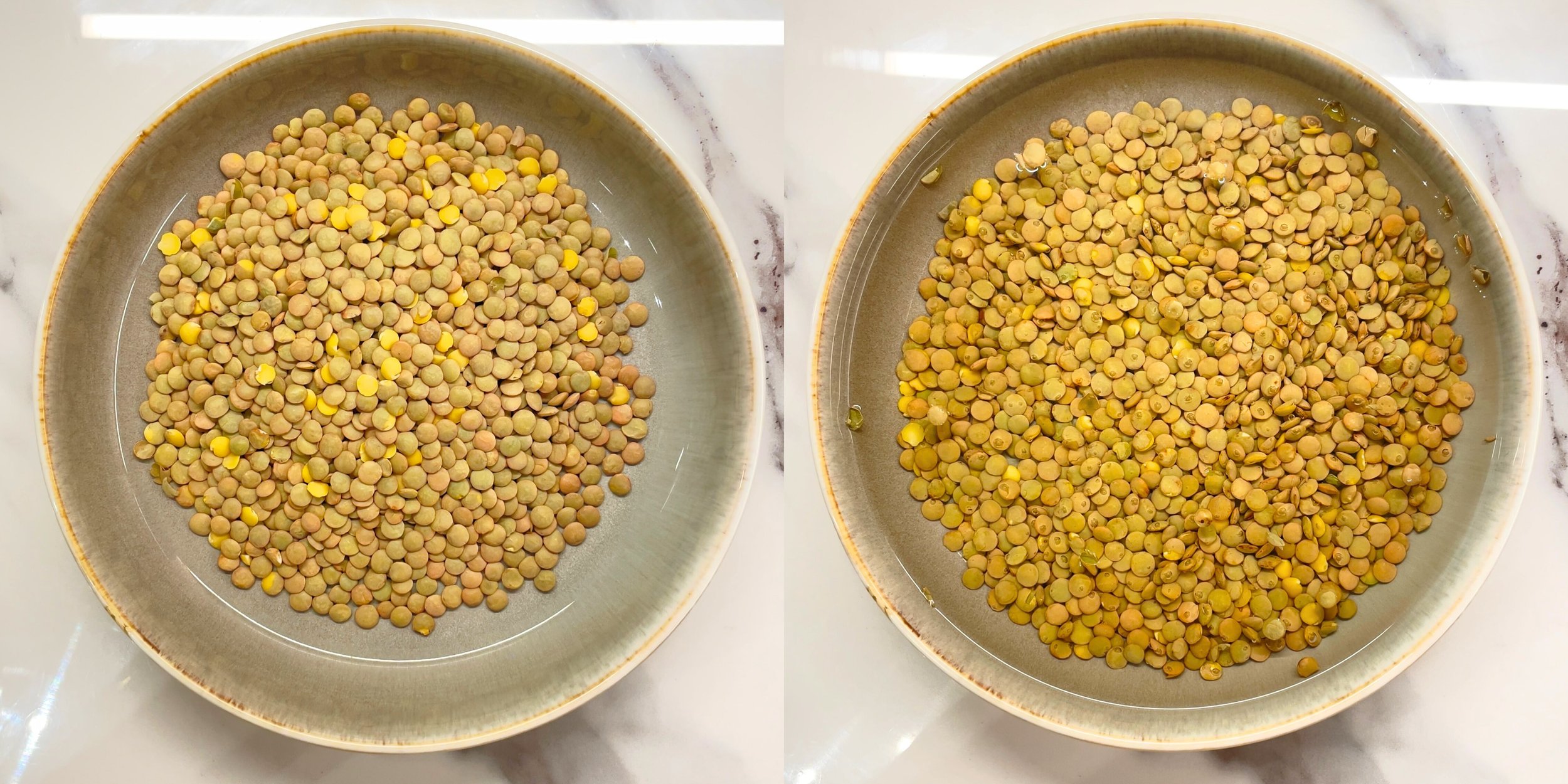Lentil-Stuffed Sweet Potato Boats
Sail away into the land of sweetness with these ghee-licious lentil-stuffed sweet potato boats. I first made these while serving as karma yogi chef at Sivananda Bahamas. They were a hit; the recipe was originally inspired by a fellow kitchen karma yogi who had made roasted sweet potatoes topped with spiced chickpeas several days before. That same karma yogi came up with the creative name; the rest is history. I love making these whenever I feel spacey or like I need to slow down. The warmth of this recipe is both literal and subtle, leaving you feeling grounded and satiated.
The sweet taste is especially pacifying for both Vata and Pitta. As we exit Pitta season (summer) and enter Vata season (fall), it’s advisable to include vibrant and delicious root vegetables like sweet potatoes in our diets. Vata is the dosha ruled by air and space; it’s known for its flightiness, creativity, and capacity for constant change. Vata season typically begins during fall and lasts until mid-winter (times will vary depending on the geography of your location). This season is known to be cool, dry, and, if left unbalanced, this season can bring along a sense of unease, dissatisfaction, and fickleness. For those of us who are Vata-dominant or prone to Vata imbalances (like I am), this season can be especially trying; thankfully, Ayurveda tells us that we can control our mental, emotional, and spiritual (im)balances via the food we eat. For these reasons and many more, this recipe is perfect to start off the fall season here at 7YGH.
These sweet potatoes are a great way to reconnect with our physical and sensory bodies; they’re extremely nourishing, with plenty of plant-based fiber, protein, vitamins, and minerals. Sweet potatoes are chock full of age-defying (and free radical-fighting) antioxidants as well as beta carotene (used by the body to make vitamin A, which is essential for eye health). Lentils are a great source of iron, folate, and B vitamins. This recipe is extremely supportive for the digestive system, too, and won’t feel heavy in the stomach even if eaten late in the day.
Food for Thought: What Makes a Recipe Yogic?
We all know that our food impacts our physical health, state of mobility, overall flexibility, and energy levels. Yogis take it a step further to say that the quality of our thought is also directly related to the nature of our food. Certain foods will stimulate the nervous system and aggravate the mind, while others will create inertia in the body and lethargy in the mind. The yogic diet seeks a middle way, focusing on the principles of balance. The ideal diet for a yogi is one that supports the body by providing ojas (“vigor”, the vital energy underlying immunity and strength) without compromising the quality of the mind.
The Qualities of Food: Sattva, Rajas, Tamas
Food can be categorized into one of three qualities: Sattva, Rajas, or Tamas. Sattvic foods are light, healthy, and fresh; they promote mental clarity and are the preferred quality of food for yogis. Rajasic food stimulates the nervous system, increases motivation, and creates desires. Tamasic foods generate a lethargic, restful quality in the body and a dullness in the mind.
Even though yogis seek to eat predominately Sattvic food, it is key to understand that we need all three qualities to function; without Rajas, we wouldn’t be able to move a finger and without Tamas we wouldn’t be able to sit still for meditation. Also, your diet will vary depending on your constitution (the nature of your personality, energy levels, and body), state of digestion, and goals for spiritual practice. The diet of a karma yogi, someone who is vigorously active in the world, will look different from that of a hatha yogi, someone who is prioritizing long hours of steady postures, breathwork, and meditation. Finally, make note that preparation has much to do with the final quality of the food: food that is home-cooked with love and eaten immediately (versus reheated a day or two later), will have a higher quality of Sattva. The longer food sits in the fridge, the more it is imbued with the quality of Tamas.
For the purposes of our recipes, we strive to provide you with recipes that are Sattva-predominant, Vegetarian or Vegan, and Yogi-approved.
“Mind is made up of food.”
— Chandogya Upanishad
Go to...
i. Ayurvedic Ingredient Profileii. Nutrition Facts
iii. Ingredients
iv. Recipe
v. Suggestions for Experimentation
Disclaimer: I am not an Ayurvedic practitioner—I am a yoga teacher with a keen interest in attending Ayurvedic talks and workshops as well as reading Ayurvedic research and literature.
Sweet potatoes have lots of fiber and complex carbs. That means they make us look and feel great; fiber and complex carbs keep us feeling satiated longer while boosting digestion. This root vegetable has an incredible vitamin content that supports a healthy heart, circulation, and eyes. According to Ayurveda, sweet potatoes (and other root vegetables) are grounding; that means they’re excellent for pacifying Vata or, in plain-speak, for bringing us back to Earth when we feel spacey, agitated or jumpy, and lost in our thoughts. Even though sweet potatoes are grounding, they’re not heavy; they’re one of the rare Ayurvedic comfort foods that feel light in the stomach.
Green lentils have a robust, mildly peppery flavor. They’re full of protein, B vitamins, iron, and folate, making them an excellent choice for a plant-based or vegetarian diet. The high fiber content supports bowel movement and overall gut health while various minerals (zinc, copper, manganese, etc.) help keep bones healthy and strong while boosting our body’s natural ability to heal itself. Ayurveda recommends soaking lentils to make them easy to digest; lentils have tannins, water-soluble polyphenols that decrease the metabolization of energy and absorption of protein. Soaking for 2-4+ hours removes many of these tannins.
Ghee (otherwise known as clarified butter) is sweet, cooling, and an Ayurvedic superfood. It doesn’t have any lactose and casein, making it suitable for people who cannot digest dairy. It’s a main source of butyrate fatty acid, which has powerful anti-inflammatory qualities and is vital for maintaining gut health (and fighting bloating, constipation, IBS, Crohn’s disease, ulcerative colitis, and leaky gut syndrome). Ghee is also a significant source of conjugated linoleic acid (CLA), which reduces body fat deposits and boosts immune function. In Ayurveda, ghee is considered balancing for all doshas and is a well-known catalyst (anupana). It improves absorption of nutrients and works as a potent carrier agent that increases the medical benefits of the foods it is consumed with. It is important to use ghee sparingly; depending on your constitution, you should consume no more than 1-2 tbsp ghee per day.
Black pepper is a warming spice with a pungent taste. It pacifies Kapha (qualities of earth and water like heaviness, lethargy) and Vata (qualities of air and space like anxiety, absent-mindedness). It’s used in Ayurveda to improve digestion and alleviate symptoms of respiratory disorders like cough and congestion.
Himalayan pink salt (also known as saindava lavana in Ayurveda) is considered superior amongst salts and is recommended for daily use. It pacifies Vata and is essential for maintaining water electrolyte balance.
Cilantro is very calming to the immune system due to its natural anti-histamine properties. It is considered a cooling digestive herb. Because it’s good for gut health, it is used often in Ayurvedic cleanses. Cilantro is rich in immune-boosting antioxidants and fights inflammation in the body.
Serving Size 1 sweet potato
Total Servings 2
Calories Per Serving 357 calories
The nutrition facts below are Per Serving (1 sandwich) and based off of the brands mentioned in the ingredients section below!
Fat 3.6 g
Carbohydrates 68 g
Dietary Fiber 11.9 g
Sugars 6.4 g
Protein 14.6 g
Vitamin & mineral content below is not complete (many nutrients have been left out). The Daily Value (DV) percentage is based on a daily 2,000-calorie diet.
Calcium 6% DV
Iron 25% DV
Vitamin C 7% DV
Vitamin B6 20% DV
Beta-Carotene 73% DV
Potassium 12% DV
Magnesium 11% DV
2 sweet potatoes (cut in half)
1/2 cup of dry green lentils
1 tsp ghee
1/2 tsp Himalayam pink salt
1/2 tsp black pepper
1/4 cup cilantro, minced
Cilantro leaves, whole, for presentation
1. Soak lentils for 2-4 hours before cooking. If short on time, even 30 minutes to an hour helps a lot! We soak the lentils to remove tannins, polyphenols that are considered to be anti nutrients; anti nutrients block the absorption of nutrients (and minerals). You can soak lentils overnight if you need to, but try not to soak over 8-12 hours; if you are soaking longer, change the water. Make sure to remove any floaters while soaking.
2. Preheat the oven and prepare the sweet potatoes. Preheat oven to 400 degrees Fahrenheit. Dress sweet potatoes in salt, pepper, and ghee.
3. Cook sweet potatoes. Allow sweet potatoes to roast in oven for 45 minutes to 1 hour. Time will depend on the thickness of sweet potatoes. You’ll never the sweet potatoes are done when they’ve gained a beautiful deep amber oily glisten as their top layer. Once the sweet potatoes are ready, turn the oven off. Do not remove the sweet potatoes, keep them in the oven so that they remain warm.
4. Cook lentils. Drain and rinse lentils. Combine 1.5 cups of water with lentils in pot. Cook on medium-high until you reach a boil; then lower heat to a simmer, cover pot, and cook for 15-20 minutes, until lentils have reached your preferred level of tenderness. For this recipe, I appreciate an extremely tender, falling-apart lentil—this makes it easier to mix lentils with the innards of the sweet potatoes.
5. Prepare sweet potatoes for stuffing. Use a small spoon to carefully scoop out the innards of the sweet potatoes—carefully, so as to not tear the skin of the sweet potatoes. Scoop the innards in the middle.
6. Make stuffing. Combine sweet potato innards in bowl with lentils (drained). Mash together. Taste and adjust seasonings, adding more salt or pepper as needed.
6. Stuff sweet potatoes. Scoop the stuffing into the sweet potatoes.
7. Garnish with cilantro. Mince cilantro, making sure to reserve a couple sprigs of cilantro for presentation. Pile minced cilantro on top of stuffed sweet potatoes; add whole cilantro leaves for looks and serve immediately to enjoy the warmth.
Make it vegan. Sub olive oil for ghee. Cook for longer at 350 degrees Fahrenheit (olive oil has a smoking point between 350⁰ - 410⁰ F).
Experiments with spices. You can try a dash of paprika, some Asafetida, cumin (or cumin seeds), fennel (or fennel seeds), or increase the heat with a little cayenne.
Experiment with herbs. We used cilantro because 1, we love cilantro, and 2, it’s a cooling and cleansing herb that’s perfect for hot Miami weather. For similar cleansing benefits, try parsley or basil instead. For the cooling sensation, try mint instead.
Try a different legume. You can stuff these bad boys with a different lentil (black or red would both be interesting), chickpeas, or green or yellow split peas.










